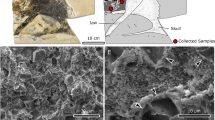Summary
A histochemical analysis involving tinctorial and solubility tests was pursued in conjunction with electron microscopy for the purpose of identifying the dark brown epidermal pigment of a barnacle (Balanus eburneus) as melanin and/or ommochrome. Histochemically, comparisons were made with other brown pigments located in the subcarapal epidermis of another crustacean, the fiddler crab (Uca pugilator), the dorsal skin of the red-backed salamander (Plethodon cinereus), the liver and testis of a slider turtle (Chrysemys sp.) and the substantia nigra of human brain. The solubility properties of the pigment of the two crustacean invertebrates were in general similar to one another and markedly different from the pigment of the three vertebrates. Insolubility in appropriate solvents classified the vertebrate pigment as melanin. The invertebrate pigment, however, which was soluble in the ommochrome solvents, concentrated sulfuric and formic acids and 2-chloroethanol, remained insoluble in the ommochrome solvents, dilute aqueous and methanolic hydrochloric acid and dilute sulfuric acid. On the basis of these solubilities, an unequivocal classification of the invertebrate pigment as either melanin or ommochrome did not appear possible. The tinctorial and electron microscopic properties of the barnacle pigment were also equally ambiguous in regard to its specific classification.
Similar content being viewed by others
References
Ajami AM, Riddiford LM (1971) Purification and characterization of an ommochrome-protein from the eyes of saturniid moths. Biochemistry 10:1455–1460
Bagnara JT, Taylor JD (1970) Differences in pigment-containing organelles between color forms of the red-backed salamander, Plethodon cinereus. Z Zellforsch 106:412–417
Barden H (1969) The histochemical relationship of neuromelanin and lipofuscin. J Neuropathol Exper Neurol 29:225–240
Barden H (1975) The histochemical relationships and the nature of neuromelanin. In: Brody H, Harman D, Ordy SM (eds) Clinical, morphologic, and neurochemical aspects in the aging central nervous system. Aging 1. Raven Press, New York, p 79
Barden H (1981) The biology and chemistry of neuromelanin. In: Sohal RS (ed) Age pigments. Elsevier/North Holland Biomedical Press, Amsterdam, p 155
Butenandt A, Biekert E, Linzen B (1956) Über Ommochrome VII, Mitteilung. Modellversuche zur Bildung des Xanthommatins in vivo. Hoppe-Seyler's Z Physiol Chem 305:284–289
Eakin RM, Brandenburger JL (1971) Fine structure of the eyes of jumping spiders. J Ultrastruct Res 37:618–663
Eloffsson R, Hallberg E (1973) Correlation of ultrastructure and chemical composition of curstacean chromatophore pigment. J Ultrastruct Res 44:421–429
Fitzpatrick TB, Szabo G, Seiji M, Quevedo WC (1979) Biology of the melanin pigmentary system. In: Fitzpatrick TB, Eisen AZ, Wolff K, Freedberg IM, Austin K (eds) Dermatology in general medicine, 2nd edn. McGraw-Hill, New York, p 131
Forrest HS (1959) The ommochromes. In: Gordon M (ed) Pigment cell biology. Academic Press, New York, p 169
Glassman E (1957) Tyrosinase-produced quinones and the disappearance of kynurenine in larval extracts of Drosophila melanogaster. Arch Biochem Biophys 67:74–89
Goodwin TW (1971) Pigments-arthropoda. In: Florkin M, Scheer BT (eds) Arthropoda, Part B. Academic Press, New York, p 279
Green JP (1964) Morphological color change in the fiddler crab, Uca pugnax (S.I. Smith). Biol Bull 127:239–255
Green JP (1969) An autoradiographic analysis of melanogenesis in the fiddler crab, Uca pugnax (S.I. Smith). Biol Bull 137:277–285
Green JP (1973) Aspects of the pigmentary system of the decapod crustacean Uca pugnax. Malays J Sci 2 (A):29–38
Green JP, Neff MR (1972) A survey of the fine structure of the integument of the fiddler crab. Tissue Cell 4:137–171
Hack MH, Helmy MF (1964) A comparative chemical study of the liver of various vertebrates. Acta Histochem 19:316–328
Hanser von G (1964) Trägergranula und Ommochrompigmente in den Augen verschiedener Rassen und Transplantat-Träger von Ephestia kubniella Z. und Ptychopoda seriata Schok. Z Naturforsch 1:396–399
Inagami K (1954) Mechanism of the formation of red melanin in the silk-worm. Nature 174:1105
Jimbow K, Quevedo WC, Fitzpatrick TB, Szabo G (1976) Some aspects of melanin biology: 1950–1975. J Invest Dermatol 67:72–89
Koulish S, Klepal W (1981) Ultrastructure of the epidermis and cuticle during the moultintermoult cycle in two species of adult barnacles. J Exp Mar Biol Ecol 49:121–149
Lea AJ (1945) A neutral solvent for melanin. Nature 156:478
Lea AJ (1952) Solubility of melanins. Nature 170:709
Lightner DV, Redman R (1977) Histochemical demonstration of melanin in cellular inflamatory processes of penaeid shrimp. J Invert Pathol 30:298–302
Lillie RD (1957) Ferrous ion uptake. A specific reaction of the melanins. Arch Path 64:100–103
Lillie RD (1969) Histochemistry of melanin. In: Wolman M (ed) Pigments in pathology. Academic Press, New York, p 327
Lillie RD, Burtner HJ (1953) The ferric ferricyanide reduction test in histochemistry. J Histochem Cytochem 1:87–92
Lillie RD, Fullmer HM (1976) Histopathologic technic and practical histochemistry, 4th edn. McGraw-Hill, New York, p 942
Lillie RD, Stotz EH, Emmel VM (1977) HJ Conn's biological stains, 9th edn. Williams and Wilkins Co., Baltimore, p 487
Millott N, Jacobson FW (1952) The occurrence of melanin in the sea-urchin, Diadema antillarum. Philippi. J Invest Dermatol 18:91–95
Needham AE (1970) The integumental pigments of some isopod crustacea. Comp Biochem Physiol 35:509–534
Needham AE, Brunet PC (1957) The integumental pigment of Asellus. Experientia 13:207–209
Nicolaus RA (1976) Melanins. Hermann, Paris, p 310
Pearse AGE (1968) Histochemistry. Theoretical and applied, Vol I, 3rd edn. Little, Brown, Boston, p 759
Sealy RC, Hyde JS, Felix CC, Menon IA, Prota G (1982) Eumelanins and pheomelanins: Characterization by electron spin resonance spectroscopy. Science 217:545–547
Taft EB (1949) Melanin solubility in tissue sections. Nature 164:1133–1134
Author information
Authors and Affiliations
Rights and permissions
About this article
Cite this article
Barden, H., Koulish, S. The dark brown integumentary pigment of a barnacle (Balanus eburneus). Histochemistry 78, 41–52 (1983). https://doi.org/10.1007/BF00491110
Accepted:
Issue Date:
DOI: https://doi.org/10.1007/BF00491110




